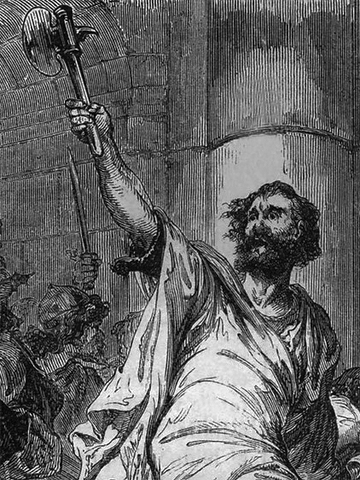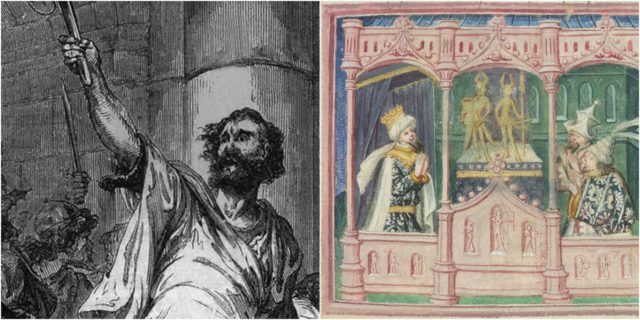In June 793, an Anglo-Saxon monk wrote sorrowfully that “heathen men came and miserably destroyed God’s church on Lindisfarne, with plunder and slaughter.” The Viking age had begun. But while some of the Scandinavian leaders remain well known, some of the most dreaded figures of the era have been all but forgotten.
10 Hastein


The Viking chief Hastein had a lengthy and blood-spattered career pillaging France and England. But during his time, he was supremely infamous for his voyage to the Mediterranean in 859 AD. After invading Algeria, the Vikings found an island to see out the winter. To their amazement, the Mediterranean continued to stay warm all throughout the winter.
Hastein was also astonished to discover he was close to Rome. The seat of the Church would certainly be a dazzling prize, and Hastein was determined to plunder the city. Sailing down the western coast of Italy, the Vikings move toward the largest city they had ever sighted.
Hastein realized the walls were too enormous for him to take the city by force. As an alternative, he landed ashore and told his men to ask for a Christian funeral for their “dying” leader. The Italians accepted and decided to permit Hastein’s men to carry him through the gateways. Of course, the chieftain quickly leaped from his casket and looted the city.
He sailed away, weighed down with plunder. He discovered soon after that he had actually taken the town of Luna, mistaking it for the city of Rome.
9 Sigurd the Stout
Sigurd the Stout was the Norse leader of Orkney, a small island located off the north coast of Scotland. He led Orkney to power above the Hebrides islands and vast areas of mainland Scotland.
He was well known for his usage of a raven banner; a pagan sacred symbol soared by more than a few Viking raiders. The chronicles state that Sigurd’s raven banner was completed by his mother, and prepared him unconquerable in combat.
However, Sigurd was defeated by the Norse King Olaf Tryggvason, who forced him to adopt Christianity and took his son to Norway as a captive. The son soon perished, and Sigurd was able to reverse his conversion. He flew his raven banner one last time at the Battle of Clontarf, where he was slain by the armies of the Irish king Brian Boru.
8 The Donkey-Rider
The Persian writer Abu Miskawayh and the Kurdish chronicler Ali Ibn al-Athir both chronicled an attack on the detached Caspian Sea in 943 AD. According to Miskawayh, a Viking convoy of ships carried overland headed to the Caspian and at then sailed up the Kura River to attack the wealthy city of Barda’a. The leader of the voyage rode a donkey, but the Muslim chroniclers never learned his name.
After devastating an army of 5,000 men, the Vikings sacked Barda’a and slaughtered thousands of its inhabitants. The Persian governor of the region transported up reinforcements and besieged the city, but his kinsmen were overwhelmed by the aggressors and the Vikings forced a withdrawal once an epidemic of dysentery had weakened them.
The donkey-riding chief perished in the breakout effort, but his remaining men were able to slip away under cover of darkness and make it back to their ships. The Persians excavated the graves they left behind to recover the valuable swords buried with the dead warriors.
7 Ingvar The Far-Traveled
The Vikings came back to the Caspian in the 1040s when the warrior Ingvar the Far-Traveled commanded a voyage beginning from Sweden. After spending a few years with the Kievan Rus, Ingvar headed off again in search of plunder.
Georgian storytellers reference a group of Vikings who aided King Bagrat IV of Georgia in a battle against some rebels. These are commonly presumed to be Ingvar’s men, especially as the scenery in a saga about him seems to describe the Georgian terrain.
After that, Ingvar is thought to have traveled further east, into Muslim domains near the Caspian Sea. The tales and rune stones reach an agreement that his entire party died of sickness there, a rather underwhelming conclusion for such a fearsome warrior.
6 Brodir Of Man
After Brian Boru became King of Ireland in 1002 AD, Viking supremacy in the Emerald Island was seriously under threat. The Norse ruler of Dublin, Sigtrygg Silkbeard, chose to support an uprising against Brian. He was encouraged by his mother, Gormflaith, who was Brian’s estranged wife.
Under Gormflaith’s influence, Sigtrygg drafted warriors from all over the Viking domain, as well as Sigurd the Stout. He also sent an appeal to the Isle of Man, which was ruled by two brothers called Brodir and Ospak, who supposedly unmatched sorcerers. Brodir agreed to fight, but Ospak believed that they would be defeated, and he left under cover of darkness to join Brian.
At the Battle of Clontarf, Brodir was thought to have slain masses of Irishmen. Nevertheless, Clontarf was a massacre, and Brodir wisely ran away into the woods when presented an oppurtunity. According to Njal’s Tale, he unintentionally ran into King Brian, who was waiting to hear the result of the battle. Overpowering Brian’s protectors, Brodir killed the king in personal combat.
The Tale later recounts that Brian’s brother Wulf the Quarrelsome chased Brodir down, nailed his intestines to a tree, and forced him to walk around it until they were pulled out.
5 Raud The Strong
According to the 12th-century Icelandic historian Snorri Sturluson, Raud ran afoul of King Olaf Tryggvason, who was attempting to convert Norway to Christianity. Raud refused the king’s demands, and openly ridiculed the Christians.
This enraged Olaf, who ordered Raud to be imprisoned. When the stubborn pagan still refused to be baptized, Olaf had him tied down, and a drinking horn pushed down his throat. Then he pressed a snake into the horn and prodded it with a scorching iron up until it slithered down Raud’s throat and into his stomach.
According to Snorri, Raud died when the snake chewed its way out through his side. Since snakes can’t really gnaw, the story might not be true.
4 Ivar The Boneless
According to Ragnar’s Saga, Ivar the Boneless was the son of the legendary warrior Ragnar Lodbrok. This may or may not be true, but we do know that Ivar and his brothers led the Great Heathen Army, a vast force that attacked England in 865.
They attacked the kingdoms of East Anglia and Northumbria and decimated the Kingdom of Mercia. King Aella of Northumbria was tortured to death, and Edmund of East Anglia used as target practice for the Norse archers. Once Ivar came back to York he vanished from the record, leaving command of the army to his brothers.
Ivar’s nickname has remained the subject of abundant rumor. The Chronicles come to an agreement that he had to be carried around on a shield, and Ragnar’s Tale states that he had “only the like of gristle where his bones should have been.” This has led some historians to speculate that he suffered from osteogenesis imperfecta, a disorder that leaves bones delicate and easily broken.
3 Imar
Before Ivar the Boneless arrived in England, a Viking leader named Imar invaded Ireland, where he seized control of Dublin and raided the region. After Ivar had left England, Imar resurfaced in Scotland, where he surrounded the stronghold of Dumbarton Rock.
The siege persisted for months. Nonetheless, the Vikings were ultimately able to cut off the water supply, and the defenders surrendered. The King of Strathclyde was taken hostage, and 200 ships were needed to carry away the wealth. Imar then came back to Ireland, where he perished of a “revolting disease” in 873.
Many historians wonder whether Imar and Ivar were the same person, even though the Scottish and Irish archives on no occasion mention to the “boneless” diminutive.
2 Gunderedo
The first Viking invasion of Spain sacked the Muslim city of Seville in 844. Later attacks on Muslim Spain were less successful, and the biggest Viking incursion into Spain was aimed at the Christian north.
The attack was in progress when Richard of Normandy called for Danish aid for a war in northern France. As soon as that concluded, the Danes invaded Galicia, in the northwestern region of Spain. They were commanded by a “sea-king” who the Spanish called “Gunderedo.”
Gunderedo’s men looted the holy shrine of Santiago de Compostela and murdered the local bishop. Afterward, no Galician was prepared to fight the Danes, and they marauded across the region for three years. It’s not exactly clear why they left, but by the time they went home there was probably nothing left to steal.
1 Thorstein The Red
Thorstein the Red was the son of King Olaf of Dublin and his legendary queen, Aud the Deep-Minded. Aud’s family reigned in the Hebrides, and Olaf had wedded her in the hope of achieving a treaty. However, the Islanders attempted to invade Dublin, and Olaf sent Aud and the newborn Thorstein home in rage.
Olaf’s consolidated his power, and he took over the Hebrides, forcing Aud to flee to Scotland with her child. Thorstein was raised to become a ferocious warrior, who fought all across Scotland and “was ever triumphant.” The despairing Scots even granted him his own kingdom located in the north of the country.
But Thorstein sought more, and the Scots collaborated to have him assassinated in 900 AD. Brokenhearted, Aud took her followers to Iceland, where she became the ruler of a poweful clan.

